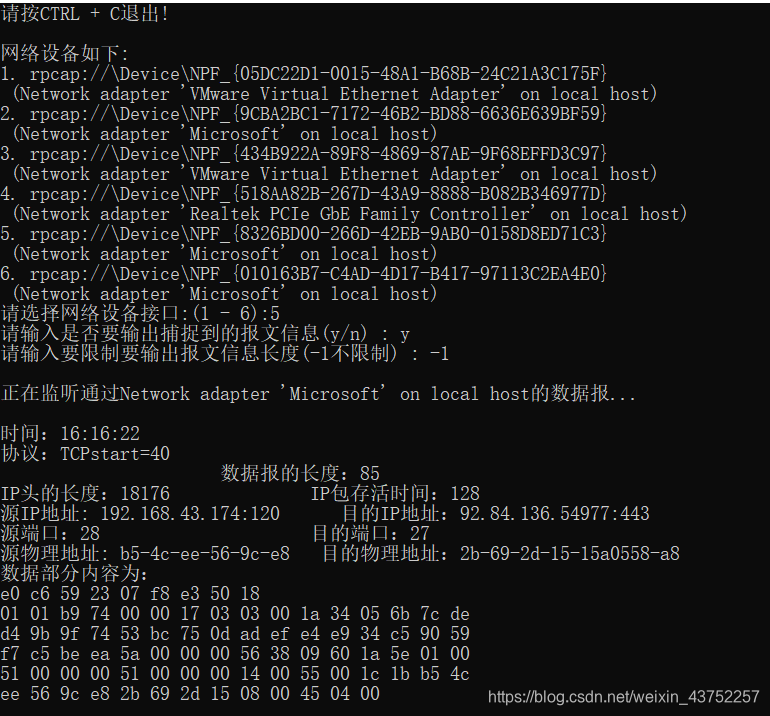一、题目
网络嗅探器
二、环境
Win10 codeblocks
三、代码实现
winpcap要在CB中使用,还需配置一些.h文件,请自行百度,百度上有。
请熟悉教材IP数据包的格式,以及头部协议部分。
代码如下:
#define HAVE_REMOTE//宏定义
#define LINE_LEN 16
#include "winsock.h"
#include <string.h>
#include "pcap.h"
#pragma comment(lib, "Ws2_32.lib")
typedef struct ip_address
{
//ip地址
u_char b1;//u_char无符号char
u_char b2;
u_char b3;
u_char b4;
} ip_address;
typedef struct mac_address
{
//mac地址
u_char b1;
u_char b2;
u_char b3;
u_char b4;
u_char b5;
u_char b6;
} mac_address;
typedef struct ethe_header
{
//mac帧首部
mac_address mac_dest_address;//目的地址
mac_address mac_source_address;//源地址
u_short ether_type;//长度或类型
} ethe_header;
typedef struct ip_header
{
//ip地址首部
u_char ver_ihl;//版本号和头长度各占4位
u_char tos;//服务类型
u_short tlen;//分组长度
u_short identification;//分组标识,唯一标识发送的每一个数据报
u_short flags_fo;//标志
u_char ttl;//生存时间,TTL
u_char proto;//协议可以是TCP,UDP,ICMP等
u_short crc;//校验和
ip_address saddr;//源IP地址
ip_address daddr;//目的IP地址
u_int op_pad;// 选项与填充
} ip_header;
typedef struct udp_header
{
//UPD首部
u_short sport;//源端口号
u_short dport;//目的端口号
u_short len;//包长度
u_short crc;//校验和
} udp_header;
typedef struct tcp_header
{
//TCP首部
u_short sport;//16位源端口号
u_short dport;//16位目的端口号
u_int num;//32位序列号
u_int ack;//32位确认号
u_short sum;//可能是包长度
u_short windonw;//16位窗口大小
u_short crc;//16位校验和
u_short ugr;//16位紧急数据偏移量
} tcp_header;
void packet_handler(u_char * param, const struct pcap_pkthdr * header, const u_char *pkt_data);
char judge;
int length;
int main()
{
pcap_if_t * alldevs, *device;//pcap_if是winpcap这个抓包框架中自带的函数库中的主要函数之一,用来描述一个网络设备结构,
int i = 0;
int iNum;
u_int netmask;
struct bpf_program fcode;//使用于pcap_compile,格式过滤
pcap_t * adhandle;//libpcap函数库中pcap_t及pcap_dumper_t类型的数据结构
char errbuf[PCAP_ERRBUF_SIZE];
//修改这里可以更改捕获的数据包使用的协议类型
char packet_filter[] = "(ip and udp) or (ip and tcp) or (ip and icmp)";
if (pcap_findalldevs_ex(PCAP_SRC_IF_STRING, NULL, &alldevs, errbuf) == -1)
{
//获取设备列表
fprintf(stderr,"无法打开网络设备:%s\n", errbuf);
return 1;
}
for (device = alldevs; device != NULL; device = device->next)
{
//打印列表
if (i == 0)
{
printf("请按CTRL + C退出!\n\n");
printf("网络设备如下:\n");
}
printf("%d. %s\n", ++i, device -> name);
if (device->description)
printf(" (%s)\n", device->description);
else
printf("没有设备描述信息!");
}
if (i == 0)
{
printf("\n请先安装WinPcap!");
return -1;
}
printf("请选择网络设备接口:(1 - %d):", i);
scanf("%d", &iNum);
getchar();
if (iNum < 1 || iNum > i)
{
printf("设备不存在!\n");
pcap_freealldevs(alldevs);//不需要网卡列表时,释放设备列表
return -1;
}
//跳转到已选设备
for (device = alldevs, i = 0;i < iNum -1 ; device = device -> next,i++);
// 打开适配器
if ( (adhandle= pcap_open(device->name, // 设备名
65536, // 要捕捉的数据包的部分
// 65535保证能捕获到不同数据链路层上的每个数据包的全部内容
PCAP_OPENFLAG_PROMISCUOUS, // 混杂模式
1000, // 读取超时时间
NULL, // 远程机器验证
errbuf // 错误缓冲池
) ) == NULL)
{
fprintf(stderr,"\n不能打开适配器!\n");
/* 释放设备列表 */
pcap_freealldevs(alldevs);
return -1;
}
if (pcap_datalink(adhandle) != DLT_EN10MB)
{
//检查数据链路层,为了简单,只考虑以太网
fprintf(stderr, "\n系统网卡链路出错!\n");
pcap_freealldevs(alldevs); //释放设备列表
return -1;
}
if (device->addresses != NULL) //获得接口第一个地址的掩码
netmask = ((struct sockaddr_in *)(device->addresses->netmask))->sin_addr.S_un.S_addr;
else //如果接口没有地址,那么我们假设一个C类的掩码
netmask = 0xffff00;
if (pcap_compile(adhandle, &fcode, packet_filter, 1, netmask) < 0)
{
//编译过滤器
fprintf(stderr, "不能监听过滤该数据报!\n");
pcap_freealldevs(alldevs);
return -1;
}
if (pcap_setfilter(adhandle, &fcode) < 0)
{
//设置过滤器
fprintf(stderr, "过滤设置错误!\n");
pcap_freealldevs(alldevs);
return -1;
}
printf("请输入是否要输出捕捉到的报文信息(y/n) : ");
scanf("%c",&judge);
if (judge!='n')
{
printf("请输入要限制要输出报文信息长度(-1不限制) : ");
scanf("%d",&length);
}
printf("\n正在监听通过%s的数据报...\n", device->description);
pcap_freealldevs(alldevs); //释放设备列表
pcap_loop(adhandle, 0, packet_handler, NULL); //开始捕捉
return 0 ;
}
void packet_handler(u_char *dumpfile, const struct pcap_pkthdr *header, const u_char *pkt_data)
{
//回调函数,当收到每一个数据包时会被libpcap所调用
if(header->caplen>400) return;
int len;
struct tm *ltime;
char timestr[16];
ip_header * ip_hd;
udp_header * udp_hd;
tcp_header * tcp_hd;
ethe_header * ethe_hd;
int ip_len,tcp_len,start;
u_short sport,dport;
printf("\n");
ltime=localtime(&header->ts.tv_sec); //将时间戳转换为可读字符
strftime( timestr, sizeof timestr, "%H:%M:%S", ltime);
printf("时间:%s\n",timestr);
ethe_hd = (ethe_header *)pkt_data;
ip_hd = (ip_header *)(pkt_data + 14);
ip_len = (ip_hd ->ver_ihl & 0xf) * 4; //ip首部长度
udp_hd = (udp_header *)((u_char *)ip_hd + ip_len);
sport = ntohs(udp_hd->sport);
dport = ntohs(udp_hd->dport);
if(ip_hd->proto==17)
{
printf("协议:UDP");
start=ip_len+8;
}
else if(ip_hd->proto==6)
{
printf("协议:TCP");
tcp_hd = (tcp_header *)((u_char *)ip_hd + ip_len);
tcp_len=ntohs(tcp_hd->sum)>>12;
start=ip_len+tcp_len*4;
}
else if(ip_hd->proto==1)
{
printf("协议:ICMP");
start=ip_len+23;
}
else printf("协议:其他");
printf("start=%d\n",start);
printf(" 数据报的长度:%d\n",header->caplen);
printf("IP头的长度:%d IP包存活时间:%d\n",ip_hd->tlen,ip_hd->ttl);
printf("源IP地址: %d.%d.%d.%d:%d 目的IP地址:%d.%d.%d.%d:%d\n 源端口:%d 目的端口:%d\n源物理地址: %x-%x-%x-%x-%x-%x 目的物理地址:%x-%x-%x-%x-%x-%x\n",
ip_hd->saddr.b1, ip_hd->saddr.b2, ip_hd->saddr.b3, ip_hd->saddr.b4,
ip_hd->daddr.b1, ip_hd->daddr.b2, ip_hd->daddr.b3, ip_hd->daddr.b4, sport, dport,
ethe_hd->mac_source_address.b1, ethe_hd->mac_source_address.b2, ethe_hd->mac_source_address.b3,
ethe_hd->mac_source_address.b4, ethe_hd->mac_source_address.b5, ethe_hd->mac_source_address.b6,
ethe_hd->mac_dest_address.b1, ethe_hd->mac_dest_address.b2, ethe_hd->mac_dest_address.b3,
ethe_hd->mac_dest_address.b4, ethe_hd->mac_dest_address.b5, ethe_hd->mac_dest_address.b6);
//输出数据部分
if (judge=='y')
{
printf("数据部分内容为:\n");
if(length==-1) len=(header->caplen) + 1 ;
else len=(length>header->caplen + 1-start)?(header->caplen+1)-start:length;
for (int i=start; (i < start + len ) ; i++)
{
printf("%.2x ", pkt_data[i-1]); //也可以改为 %c 以 ascii码形式输出。
if ( (i % LINE_LEN) == 0) printf("\n");
}
printf("\n\n");
}
}
四、实验结果
